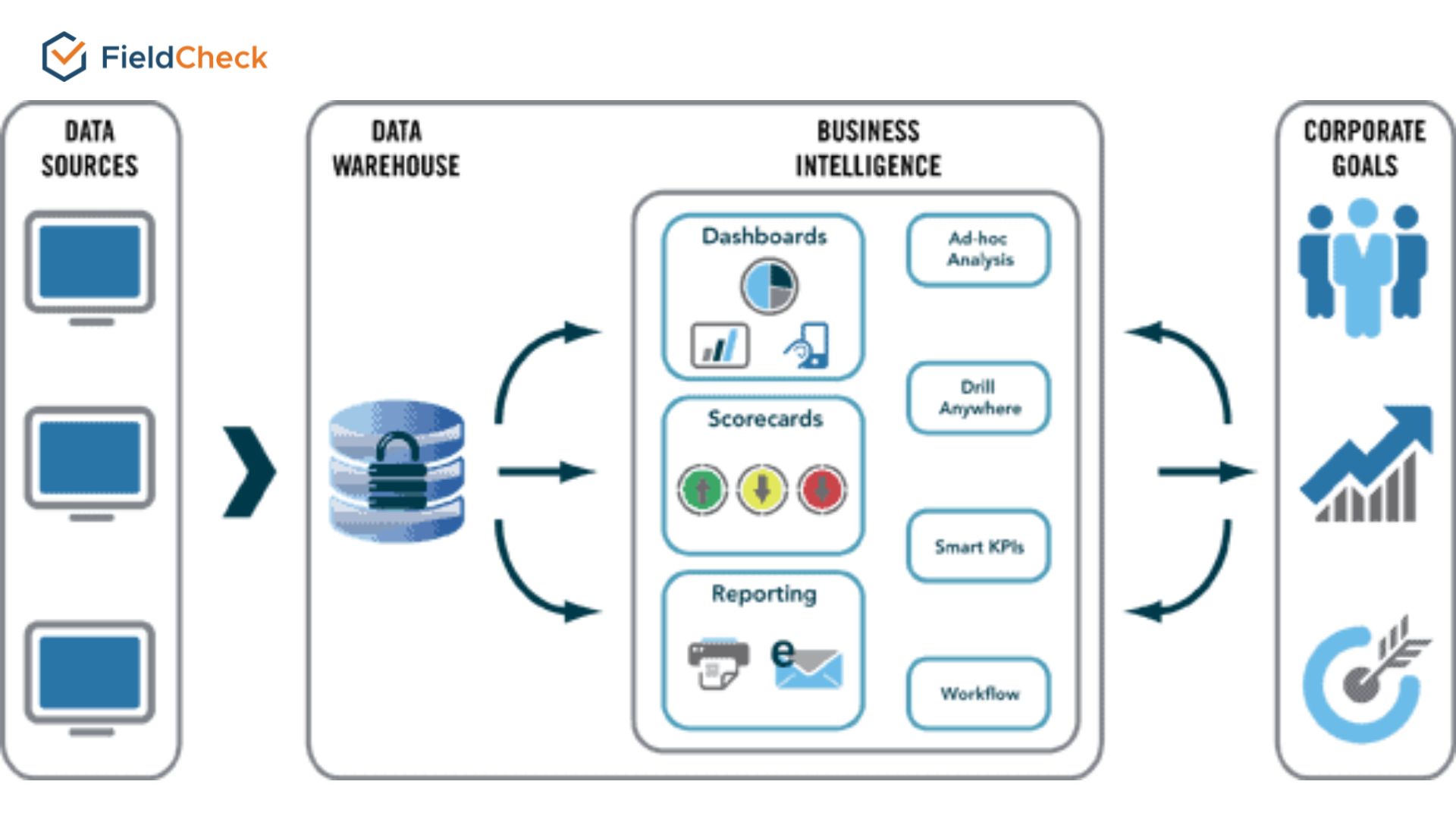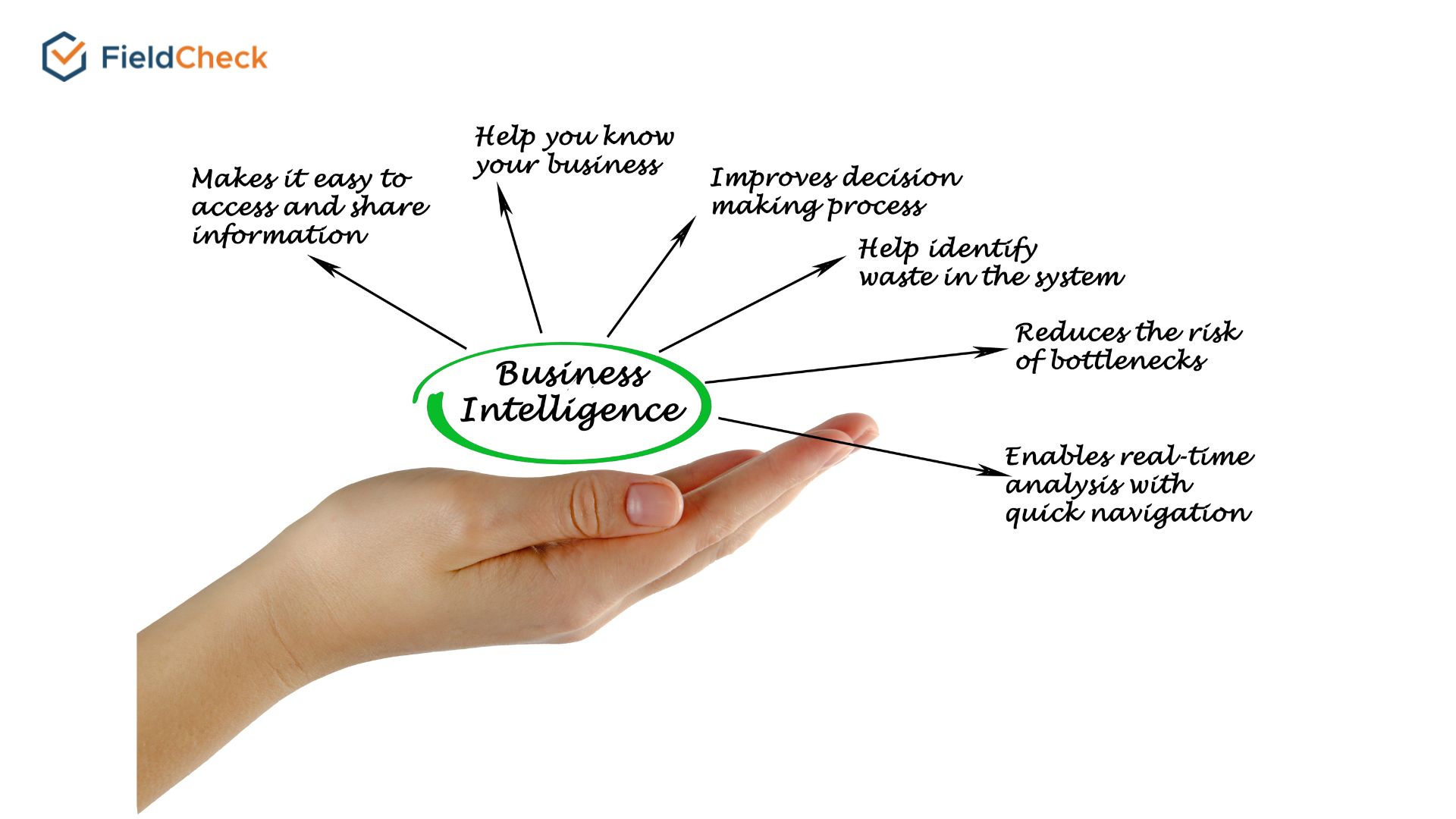What Is Business Intelligence (BI)? Its Importance And Best Practices For A Good BI Strategy
Business Intelligence is an effective support tool for big business leaders today. However, this is a fairly new and strange concept to many people in Vietnam.
Therefore, most Vietnamese enterprises still do not know about this field and have not been able to deploy BI tools into their business activities strongly.
 Business Intelligence
Business Intelligence
Let's learn with FieldCheck about the definition and how Business Intelligence works to get an overview and better understand the importance of BI in the business.
The article also provides some good examples and tips to help businesses apply BI strategies successfully.
What is Business Intelligence (BI)?
Business Intelligence (BI) is an English phrase commonly used in business. Many people translate Business Intelligence into Vietnamese as business intelligence, business knowledge, or business intelligence.
According to Solomon Negash and Paul Gray, BI can be understood as a system consisting of three main components: data collection, storage, and information management.
With a set of skills, strategies, applications, and technologies that help businesses analyze data and control business information, BI systems can support decision-making and goal-setting for businesses in the future.
Leaders will also act more efficiently and accurately in today's fiercely competitive and constantly changing environment.
Reporting, online analytical processing (OLAP), metrics analytics, data mining, business performance management (BPM), benchmarking, text mining, predictive analytics, etc., are common functions of BI technologies.

BI is a system that helps businesses analyze data and control business information
How Does BI Work?
Before learning how a BI system works, let's define the key components of Business Intelligence.
Key Elements In BI
Data Sources
The first component and also an important step to get data in the system is to collect data from various sources from many different formats such as customer management systems (CRM), systems human resource management (HRM), surveys, customer information on commercial platforms, etc.
Data Warehousing
Containing aggregated data of the enterprise and long-term storage by the enterprise's electronic device system.
Integrating Server
Support the operation of the ELT tool (short for Extract, Transform, Load) to extract and transform all data from Data sources and then load the data into the Data warehouse.
Analysis Server
The server will receive and then return the results based on the established business standards from the data input.
Reporting Server
This department will report the output data received from the Analysis Server.
Data Mining
The analysis process in BI not only stops at the basic level but also requires techniques in data mining to classify, group, predict or detect association rules.
Data Presentation
Finally, the BI system will process and aggregate the data from the Data mining process to form a graph/diagram for presentation to policymakers and decision-makers.
The main character in the operation of BI is data, that's why Data Warehouse and Data Mining are the core elements of a BI system, along with Business Analysis. to make strategic business decisions.
 Elements of Business Intelligence
Elements of Business Intelligence
How BI Works
Business Intelligence is responsible for helping businesses analyze data and make accurate predictions. Bi's main activities include decision support; query and reporting (Query and reporting), Online analytical processing; statistical analysis (Statistical analysis); prediction (Forecasting); and data mining.
From the data stored at the Data Warehouse, the BI system conducts OLAP online data analysis, aiming to support businesses in business analysis and reporting. After making forecasts, Business Intelligence will suggest appropriate and effective decisions for your business strategy.
BI technology also queries the data warehouse and presents the results to the user through reports, charts, and maps.
"OLAP provides powerful technology to help business administrators explore data, enable BI, compute complex analytics, and predictive analytics," written Doug Dailey, IBM's Chief Supply Officer.
One of the key benefits of OLAP is the consistency of the information and calculations it uses to transform data to improve product quality, improve processes, and increase customer satisfaction, he adds.
Some recent Business Intelligence solutions can also extract and import raw data directly, such as using Hadoop technology. However, in many cases, data warehouses are still the data source of choice.
The Importance of BI to Business
In addition to increasing the ability to control business information accurately and efficiently, Business Intelligence is responsible for supporting businesses in analyzing and exploiting huge amounts of information and data and making price predictions. Also, customer behavior.
From there, large enterprises, especially those operating in technology, services, and finance, can identify potential customers and offer appropriate business strategies to increase competitiveness in the market.
In addition, the application of Business Intelligence to the business apparatus also gives businesses the following outstanding benefits:
- Helping businesses adapt to a constantly changing environment and fierce business competition thanks to BI's ability to quickly capture market fluctuations.
- Make full use of information systems.
- Support the process of making timely and effective business decisions.
- Identify the position and internal capabilities of the business.
- Analyze and predict customer behavior.
- Determine the right marketing goals and strategies.
- Provides an overview of the business and future projections.
- Support in business strategy development.
- Helping businesses evaluate and improve organizational processes.
- Save time and operating costs for operating work.

Business Intelligence is applied in many different sectors and industries, such as retail, financial services, manufacturing, health, energy, technology, etc. Here are two of the many companies that have successfully applied BI in their business activities.
Financial services firm Charles Schwab used Business Intelligence to get a holistic view of all of their branches across the US to understand performance metrics and identify potential areas. Access to a central BI platform allows Schwab to bring data from its branch into a single tracking mode.
As a result, branch managers can know that their clients can change their investment needs anytime. And management can track a region's performance above or below average and click to see which affiliates are driving that region's performance. This approach gives businesses more opportunities to optimize operations and improve customer service.
The second example we present is HelloFresh, a meal kit service provider. HelloFresh has been automating reporting processes when the company's Digital Marketing department has spent too much time on this task.
With the help of Tableau, HelloFresh has saved the Marketing team 10 to 20 hours of work per day and enabled them to create more targeted and targeted marketing segmentation campaigns.
How To Develop A Successful BI Strategy?
A BI strategy is a blueprint to help you decide how to use data in your company. You must develop a strategy to apply Business Intelligence with the right technology.
Moreover, investing in a software platform is insufficient to get immediate results. Before formulating a strategy for BI, you must define three things:
- How to deploy the software?
- How to manage data analytics?
- How can you enable your employees to make informed decisions and insight based on the data provided?
A business intelligence strategy with useful insights will help your company achieve many unexpected results.
 How to develope a successful BI strategy?
How to develope a successful BI strategy?
First, your BI strategy must align with your business goals and vision. With Business Intelligence, data can drive many transformations in your organization. You can start the BI implementation process by following these steps:
1. Set Business Strategy and Goals
When building BI projects, you should create a reference plan to track progress and keep control of the situation during the application of this tool.
The more information you gather before you start, the more assured you will have a stable Business Intelligence process and easily respond to possible problems.
2. Select A Sponsor From Key Stakeholders
It would be best if you got support from senior staff. The ideal BI project sponsor choice is a senior leader.
3. Choosing the Right BI Platform And Tools
A BI software platform can do much for you, but it's not a complete BI strategy. Prioritize focus on the following features:
- Access and view related content
- Interact with data in visual form
- Collaborate with others on data analysis and share visualized analytics
4. Get Involved From Stakeholders
Business Intelligence deals with software, but that doesn't mean it's solely related to the IT department. The BI system also requires the participation of financial data and information from other departments.
If employees are properly empowered, business leaders will create a desirable work environment where people actively contribute to the company and feel fulfilled at work. It has a significant impact on the success of the BI system.

BI requires the engagement of many divisions
5. Create a BI Team
To set up and operate the Business Intelligence platform correctly, you will need the right team responsible for executing your BI strategy. Here are some roles and responsibilities for a BI project team:
Director of Analytics - Software Platform Manager
Enterprise Architect - platform integration with existing data architecture
Site admin - organize content, create user groups, and grant permissions
Data manager - data entry, documentation of processes and procedures to use the platform

BI department is very important to a business
6. Identify the Scope of BI
Determining goals and setting appropriate KPIs is also important to factor leading to the success of a Business Intelligence strategy.
Before implementing a BI software system, you must understand what this tool means for your organization. Business intelligence means using data to make business decisions. But it would help if you determined how that will work in your company's day-to-day operations and which parts of your company will use BI.
The scope of the analysis in your business needs to be clear before you move on to the next steps.
7. Prepare Data Infrastructure
Business Intelligence needs a clear data source to perform an accurate analysis. With modern BI, you can analyze data from multiple sources. We distinguish between two types of data: reliable and untrusted.
Reliable data is stored in a database or easily imported into a database like spreadsheets, customer relationship management (CRM) data, financial data, etc., which is the data you may have used in business analysis before.
Unreliable data includes emails, customer conversations, business processes, images, news items, trade journals, etc. With modern BI, you can put data in "Trusted" into a managed environment and save it for analysis.
The BI team needs to survey stakeholders and consumers of information to see what data sources they will need for analysis before implementing the BI platform.

BI needs evident data source to make accurate analysis
Conclusion
Above is the basic knowledge of Business Intelligence terminology, along with some reference steps to help you apply this method in the business process.
Hopefully, through the article, you will better understand the BI field and determine whether this is the right direction for your business. Good luck!




